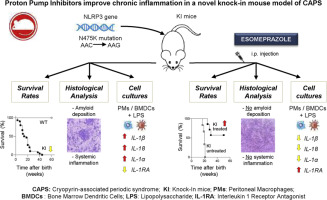当前位置:
X-MOL 学术
›
J. Allergy Clin. Immunol.
›
论文详情
Our official English website, www.x-mol.net, welcomes your
feedback! (Note: you will need to create a separate account there.)
A novel knock-in mouse model of cryopyrin-associated periodic syndromes with development of amyloidosis: Therapeutic efficacy of proton pump inhibitors.
Journal of Allergy and Clinical Immunology ( IF 11.4 ) Pub Date : 2019-06-10 , DOI: 10.1016/j.jaci.2019.05.034 Arinna Bertoni 1 , Sonia Carta 2 , Chiara Baldovini 3 , Federica Penco 1 , Enrica Balza 2 , Silvia Borghini 4 , Marco Di Duca 5 , Emanuela Ognio 6 , Alessio Signori 7 , Paolo Nozza 3 , Francesca Schena 1 , Patrizia Castellani 2 , Claudia Pastorino 1 , Carola Perrone 1 , Laura Obici 8 , Alberto Martini 9 , Isabella Ceccherini 4 , Marco Gattorno 10 , Anna Rubartelli 2 , Sabrina Chiesa 1
Journal of Allergy and Clinical Immunology ( IF 11.4 ) Pub Date : 2019-06-10 , DOI: 10.1016/j.jaci.2019.05.034 Arinna Bertoni 1 , Sonia Carta 2 , Chiara Baldovini 3 , Federica Penco 1 , Enrica Balza 2 , Silvia Borghini 4 , Marco Di Duca 5 , Emanuela Ognio 6 , Alessio Signori 7 , Paolo Nozza 3 , Francesca Schena 1 , Patrizia Castellani 2 , Claudia Pastorino 1 , Carola Perrone 1 , Laura Obici 8 , Alberto Martini 9 , Isabella Ceccherini 4 , Marco Gattorno 10 , Anna Rubartelli 2 , Sabrina Chiesa 1
Affiliation

|
BACKGROUND
Cryopyrin-associated periodic syndromes (CAPS) are a group of autoinflammatory diseases linked to gain-of-function mutations in the NOD-like receptor family, pyrin domain containing 3 (NLRP3) gene, which cause uncontrolled IL-1β secretion. Proton pump inhibitors (PPIs), which are commonly used as inhibitors of gastric acid production, also have anti-inflammatory properties, protect mice from sepsis, and prevent IL-1β secretion by monocytes from patients with CAPS.
OBJECTIVE
We sought to develop a novel Nlrp3 knock-in (KI) mouse model of CAPS to study amyloidosis, a severe CAPS complication, and test novel therapeutic approaches.
METHODS
We generated KI mice by engineering the N475K mutation, which is associated with the CAPS phenotype, into the mouse Nlrp3 gene. KI and wild-type mice received PPIs or PBS intraperitoneally and were analyzed for survival, inflammation, cytokine secretion, and amyloidosis development.
RESULTS
Mutant Nlrp3 KI mice displayed features that recapitulate the immunologic and clinical phenotype of CAPS. They showed systemic inflammation with high levels of serum proinflammatory cytokines, inflammatory infiltrates in various organs, and amyloid deposits in the spleen, liver, and kidneys. Toll-like receptor stimulated macrophages from KI mice secreted high levels of IL-1β, IL-18, and IL-1α but low amounts of IL-1 receptor antagonist. Treatment of KI mice with PPIs had a clear clinical effect, showing a reduction in inflammatory manifestations, regression of amyloid deposits, and normalization of proinflammatory and anti-inflammatory cytokine production by macrophages.
CONCLUSION
Nlrp3 KI mice displayed a CAPS phenotype with many characteristics of autoinflammation, including amyloidosis. The therapeutic effectiveness of PPIs associated with a lack of toxicity indicates that these drugs could represent relevant adjuvants to the anti-IL-1 drugs in patients with CAPS and other IL-1-driven diseases.
中文翻译:

与淀粉样变性发展有关的一种新型的冷蛋白相关的周期性综合征的敲入小鼠模型:质子泵抑制剂的治疗功效。
背景技术隐窝相关性周期性综合征(CAPS)是一组与NOD样受体家族(含有3个NLRP3基因)的吡啶结构域的功能获得性突变相关的自体炎症性疾病,这些突变导致不受控制的IL-1β分泌。质子泵抑制剂(PPI)通常用作胃酸产生的抑制剂,还具有抗炎特性,可保护小鼠免于败血症,并防止CAPS患者的单核细胞分泌IL-1β。目的我们试图建立一种新型的CAPS Nlrp3敲入(KI)小鼠模型,以研究淀粉样变性,严重的CAPS并发症并测试新颖的治疗方法。方法我们通过将与CAPS表型相关的N475K突变工程化为小鼠Nlrp3基因来产生KI小鼠。KI和野生型小鼠腹膜内接受PPI或PBS,并分析其存活,炎症,细胞因子分泌和淀粉样变性的发展。结果突变的Nlrp3 KI小鼠表现出特征,概括了CAPS的免疫学和临床表型。他们表现出全身性炎症,其中血清促炎细胞因子水平高,各器官发炎性浸润,脾,肝和肾中淀粉样蛋白沉积。KI小鼠的Toll样受体刺激巨噬细胞分泌高水平的IL-1β,IL-18和IL-1α,但分泌的IL-1受体拮抗剂水平较低。用PPI治疗KI小鼠具有明显的临床效果,显示出炎症表现的减少,淀粉样蛋白沉积的消退以及巨噬细胞促炎和抗炎细胞因子产生的正常化。结论Nlrp3 KI小鼠表现出具有许多自发性炎症特征的CAPS表型,包括淀粉样变性。与缺乏毒性相关的PPI的治疗效果表明,这些药物可能代表CAPS和其他IL-1驱动疾病患者抗IL-1药物的相关佐剂。
更新日期:2020-01-04
中文翻译:

与淀粉样变性发展有关的一种新型的冷蛋白相关的周期性综合征的敲入小鼠模型:质子泵抑制剂的治疗功效。
背景技术隐窝相关性周期性综合征(CAPS)是一组与NOD样受体家族(含有3个NLRP3基因)的吡啶结构域的功能获得性突变相关的自体炎症性疾病,这些突变导致不受控制的IL-1β分泌。质子泵抑制剂(PPI)通常用作胃酸产生的抑制剂,还具有抗炎特性,可保护小鼠免于败血症,并防止CAPS患者的单核细胞分泌IL-1β。目的我们试图建立一种新型的CAPS Nlrp3敲入(KI)小鼠模型,以研究淀粉样变性,严重的CAPS并发症并测试新颖的治疗方法。方法我们通过将与CAPS表型相关的N475K突变工程化为小鼠Nlrp3基因来产生KI小鼠。KI和野生型小鼠腹膜内接受PPI或PBS,并分析其存活,炎症,细胞因子分泌和淀粉样变性的发展。结果突变的Nlrp3 KI小鼠表现出特征,概括了CAPS的免疫学和临床表型。他们表现出全身性炎症,其中血清促炎细胞因子水平高,各器官发炎性浸润,脾,肝和肾中淀粉样蛋白沉积。KI小鼠的Toll样受体刺激巨噬细胞分泌高水平的IL-1β,IL-18和IL-1α,但分泌的IL-1受体拮抗剂水平较低。用PPI治疗KI小鼠具有明显的临床效果,显示出炎症表现的减少,淀粉样蛋白沉积的消退以及巨噬细胞促炎和抗炎细胞因子产生的正常化。结论Nlrp3 KI小鼠表现出具有许多自发性炎症特征的CAPS表型,包括淀粉样变性。与缺乏毒性相关的PPI的治疗效果表明,这些药物可能代表CAPS和其他IL-1驱动疾病患者抗IL-1药物的相关佐剂。









































 京公网安备 11010802027423号
京公网安备 11010802027423号